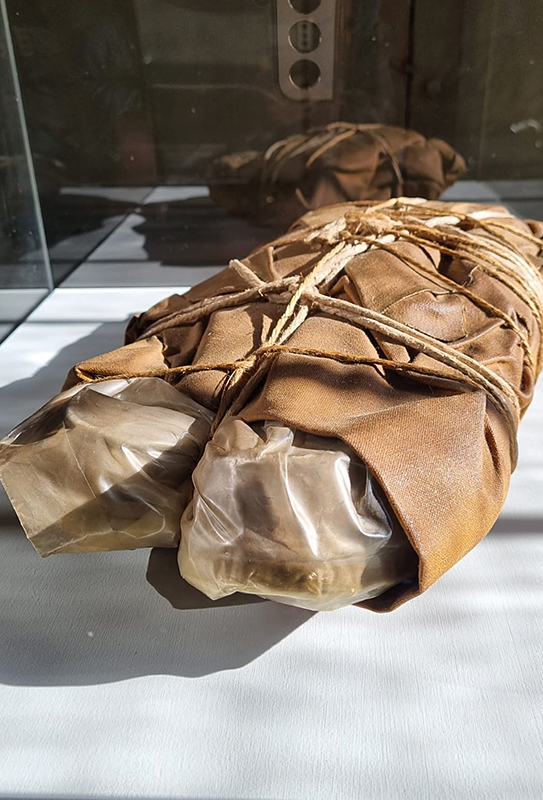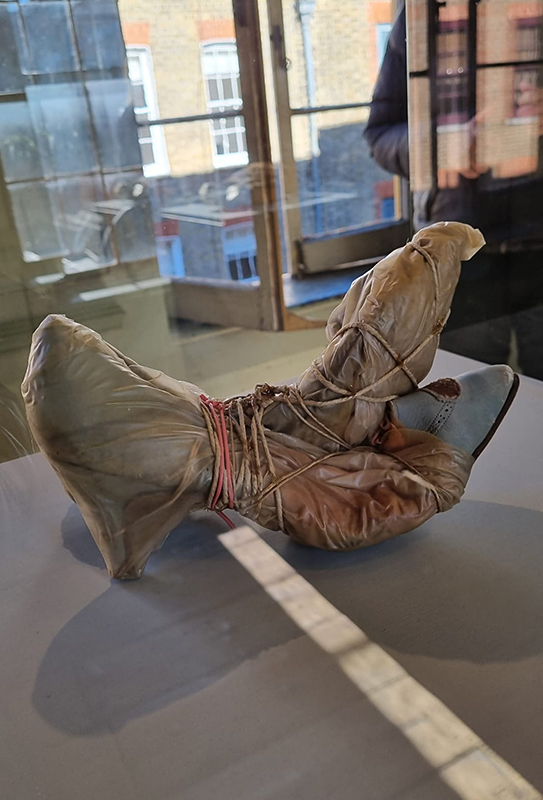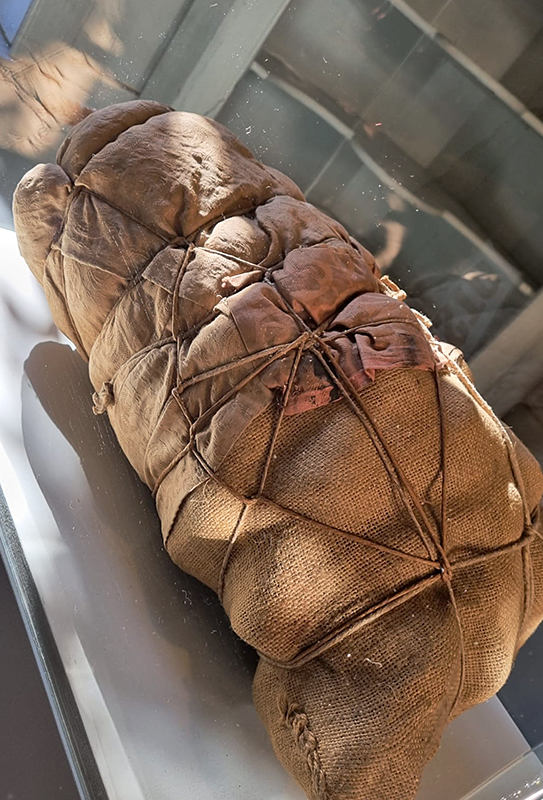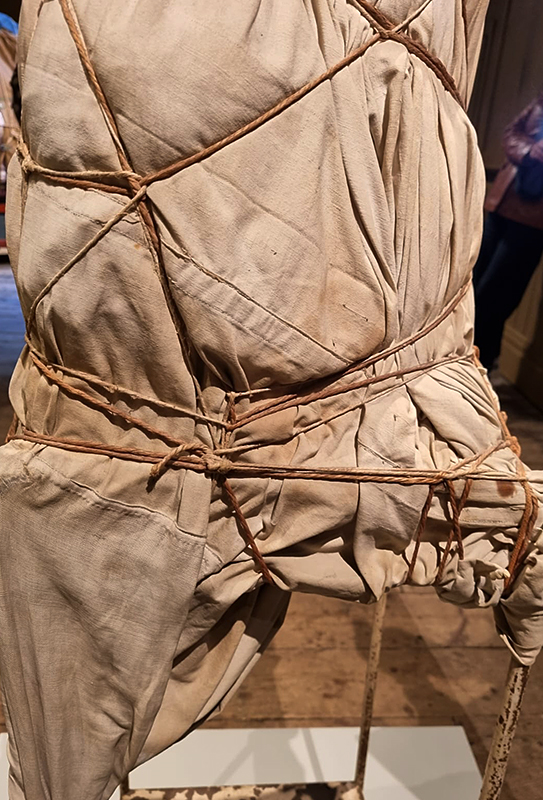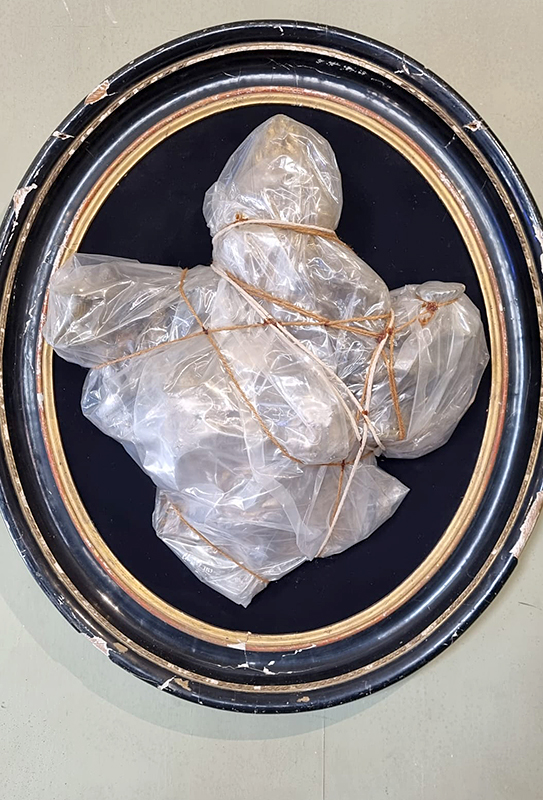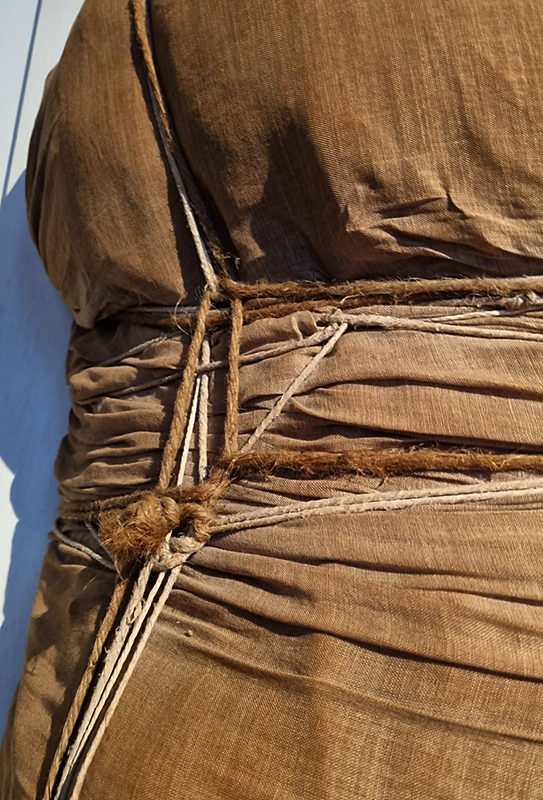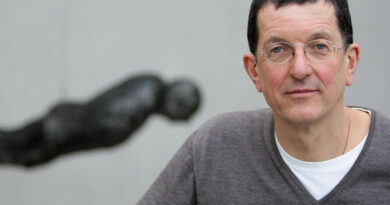christo: a monologue of packed memory
GÜLAY YAŞAYANLAR
Christo’s psychology, which becomes blurred and ambiguous at times, naturally infects the packaged things and temporarily gives the viewer the emotional atmosphere of a unique creative experience. This act of packaging, which turns into a metaphor for an existential search for meaning that seems difficult to understand, corresponds to an act of liberation for Christo. He hides what is identifiable and reaches a more emphasised but freer definition of variable object-space. Transcending emotional states, especially those related to his migrant identity, he treats a conceptualised act of packaging as a form of cultural and geographical intervention, seeing it as a way of achieving realistic dimensions of an aesthetic transformation in an ambitious and perfect way.
4– Package on table, 1961, (Detail), Metal table, can, fabric, lacquer, rope, and twine, 124×61.5×30 cm. 5– Applique Empaquetée, 1963-81, Brass condelabra, polyethylene, and rope, mounted on velvet, in antiqye wood frame, 86.4×74.3×16.5 cm. 6– Package, 1963, (Detail), Fabric, rope, twine and board, 107×84.8×30.6 cm. (All Artwork: Christo and Jeanne-Claude Foundation), (Photos by Gülay Yaşayanlar/London) [https://christojeanneclaude.net]
Christo’s recent London exhibition once again showed the sources of the will that led him to large and effective environmental presentations through the first packaged examples such as women’s shoes, prams, suitcases and chairs. [1] In these objects, which fetishise and lose their function as they are packaged, it is possible to see the traces of an inner discourse and a passion for art that ambitiously develops itself. [2]
This exhibition, with a different concept of presentation in an unusual space, was organised in an old Georgian house, which, in its damaged and traumatised state, was chosen as the perfect art space. The psychic harmony between this heterotopic space and Christo’s work is at an exciting level. It is as if an amorphous representation that emphasises mental incongruities and motivates the unconscious has been carefully created here. The space, which seems to be loaded with memories of Christo’s life, grasps and reflects the immanent language of the contradictory and complex world of meaning of the artist, who is in a state of migration at any moment, through a persistent act of packaging. [3]
a packaging that encloses time
In his early works, Christo is actually engaged in an act of packaging that encapsulates time, with a discourse that embodies the memory of the recent past through the issue of forced migration or displacement. The fact that the obligation to convey or remind a time devoted to constant remembrance is realised through the wrapping of ordinary objects shows how deep the relationship between the chosen object and time is. Therefore, Christo’s act of creation and reflection, which turns into a form of psycho-narrative, is actually a protestory attempt that liberates objects and spaces and does not belong to anyone. It is seen that the delicate border lines caused by Christo’s past reflecting his immigrant identity are only fulfilled by the creation of some deficiencies, disconnections, redundancies or damaged areas, through a freakish act of packaging.
Here, the effective instrumental situation shaped by Elena Geuna, who brings Christo’s early works together with this special space, turns into a separate and large packaging, recreating things that will disappear. This is because the images of these enclosed arrangements of objects, reconciled with the space, are metamorphosed each time and become the aphoristic accents of a memory laden with sensory traces. Because the ambiguity of a packaged narrative is always attractive. Thus, this monologue, which is the object of a deep memory that conceals itself and is loaded with images, memories and impulses that never reveal themselves, is revealed each time by the closure of an object, a structure or a space, scattering the real life hidden there.
Christo’s psychology, which becomes blurred and ambiguous at times, naturally infects the packaged things and temporarily gives the viewer the emotional atmosphere of a unique creative experience. There is no doubt that this act of packaging, which turns into a metaphor for an existential search for meaning that seems difficult to understand, corresponds to an act of liberation for Christo. In this way, he hides what is identifiable and reaches a more emphasised but freer definition of variable object-space. In particular, by transcending the emotional states related to his migrant identity, he treats the conceptualised act of packaging as a form of cultural and geographical intervention, seeing it as a way of ambitiously and perfectly achieving the realistic dimensions of an aesthetic transformation.
an ironic and profound monologue of memory
As an activist of psychic packaging, Christo’s objects in this exhibition, which transform a passionate and obsessive act into an ironic and profound monologue of memory, seem to be positioned in a cautious latent space that pierces the present with an aura surrounding memories.
Furthermore, the contrast and tension between the surreal installations and reality threateningly brings to the surface the passions caused by an obsessive commitment to packaging. Thus, the temporarily covered objects actually become sheltered psychic spaces. It should be noted at this point that Christo develops this language of packaging, in which he can use thought patterns, with a discursive rhetoric and reasoning power, and manages to skilfully incorporate it into his memory monologue.
Indeed, here, through the relationship between the hidden realities associated with fear and anxiety and the things that are packaged and contain contradictions, the essential, deep and core structures of the objects are reached. In the example of Christo, it is clearly seen that this memory experience is sublimated and packaged with the method of artistic expression, which is a fiction, and uncanny relational situations are revealed. In fact, every memory device that Christo packages reveals the obvious again; in other words, he produces new and original meanings about his own existence through a mental closure.
Gülay Yaşayanlar, Copyright © 2023 / All Rights Reserved.
See also: https://saglamart.com/christo-paketlenmis-bir-hafiza-monologu
NOTES
[1] Christo: Early Works, (Curator: Elena Geuna), 6-22 October 2023, Gagosian Open, 4 Princelet Street, London.
[2] Gagosian Open is a new project developed by Gagosian to create an alternative exhibition opportunity. Christo: Early Works is the first production in this series of independent, ambitious, temporary and specialised venues that prioritise the viewer experience with an unconventional approach.
[3] House number 4 on Princelet Street is a terraced, double-fronted, three-storey building. It has survived to the present day with its character intact, thanks to the strength of its yellow brick and wood construction materials and techniques. The building was registered as a second degree protected site in 1969 and its historical value was determined. See also: Christo, Early Works, (Exhibition Poster – Exhibition Brochure), Gagosian Open, 4 Princelet Street, October, 6-22, 2023, London.

